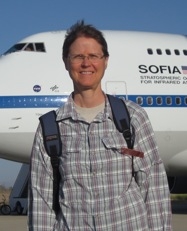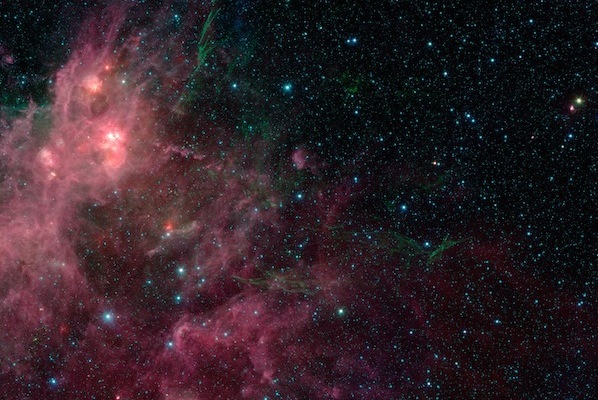Dramatic new portrait helps define Milky Way’s shape, contents
More than 2 million images like this one have been stitched together by Wisconsin astronomers to make a 360-degree portrait of the plane of our galaxy, the Milky Way. In this image, the billowing pink clouds are massive stellar nurseries. The stringy green filaments are the blown out remnants of a star that exploded in a supernova. View the entire zoomable image.
Credit: NASA/JPL-Caltech/University of Wisconsin–Madison
Using more than 2 million images collected by NASA’s orbiting Spitzer Space Telescope, a team of Wisconsin scientists has stitched together a dramatic 360-degree portrait of the Milky Way, providing new details of our galaxy’s structure and contents.
The new composite picture, using infrared images gathered over the last decade, was unveiled today at a TED conference in Vancouver. The galactic portrait provides an unprecedented look at the plane of our galaxy, using the infrared imagers aboard Spitzer to cut through the interstellar dust that obscures the view in visible light.
“For the first time, we can actually measure the large-scale structure of the galaxy using stars rather than gas,” explains Edward Churchwell, a University of Wisconsin–Madison professor of astronomy whose group compiled the new picture, which looks at a thin slice of the galactic plane. “We’ve established beyond the shadow of a doubt that our galaxy has a large bar structure that extends halfway out to the sun’s orbit. We know more about where the Milky Way’s spiral arms are.”
Related: Milky Way image on display at Town Center
Lofted into space in 2003, the Spitzer Space Telescope has far exceeded its planned two-and-a-half-year lifespan. Although limited by the depletion of the liquid helium used to cool its cameras, the telescope remains in heliocentric orbit, gathering a trove of astrophysical data that promises to occupy a new generation of astronomers.
In addition to providing new revelations about galactic structure, the telescope and the images processed by the Wisconsin team have made possible the addition of more than 200 million new objects to the catalog of the Milky Way.

Edward Churchwell
“This gives us some idea about the general distribution of stars in our galaxy, and stars, of course, make up a major component of the baryonic mass of the Milky Way,” notes Churchwell, whose group has been collecting and analyzing Spitzer data for more than a decade in a project known as GLIMPSE (Galactic Legacy Infrared Midplane Survey Extraordinaire). “That’s where the ballgame is.”
The new infrared picture, known as GLIMPSE360, was compiled by a team led by UW–Madison astronomer Barb Whitney. It is interactive and zoomable, giving users the ability to look through the plane of the galaxy and zero in on a variety of objects, including nebulae, bubbles, jets, bow shocks, the center of the galaxy and other exotic phenomena. The image is being shown for the first time this morning on a large visualization wall installed by Microsoft at the TED conference.

Barbara Whitney
The survey conducted by the Wisconsin group has also helped astronomers understand the distribution of the Milky Way’s stellar nurseries, regions where massive stars and proto-stars are churned out.
“We can see every star-forming region in the plane of the galaxy,” says Robert Benjamin, a professor of physics at the University of Wisconsin-Whitewater and a member of the GLIMPSE team.
“This gives us some idea of the metabolic rate of our galaxy,” explains Whitney. “It tells us how many stars are forming each year.”
“We’ve established beyond the shadow of a doubt that our galaxy has a large bar structure that extends halfway out to the sun’s orbit. We know more about where the Milky Way’s spiral arms are.”
Edward Churchwell
Churchwell notes, too, that while Spitzer is helping astronomers resolve some of the mysteries of the Milky Way, it is adding new cosmological puzzles for scientists to ponder. For example, the infrared data gathered by the GLIMPSE team has revealed that interstellar space is filled with diffuse polycyclic aromatic hydrocarbon gas.
“These are hydrocarbons — very complicated, very heavy molecules with fifty or more carbon atoms,” Churchwell says. “They are brightest around regions of star formation but detectable throughout the disk of the Milky Way.They’re floating out in the middle of interstellar space where they have no business being. It raises the question of how they were formed. It also tells us carbon may be more abundant than we thought.”
The new GLIMPSE composite image will be made widely available to astronomers and planetaria. The data is also the basis for a “citizen science” project, known as the Milky Way Project, where anyone can help scour GLIMPSE images to help identify and map the objects that populate our galaxy.
The data from the survey, Churchwell argues, will keep astronomers busy for many years: “It’s still up there. It’s still taking data. It’s done what we wanted it to do, which is to provide a legacy of data for the astronomical community.”




